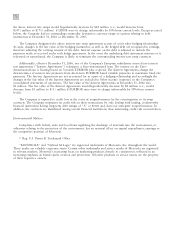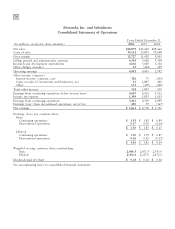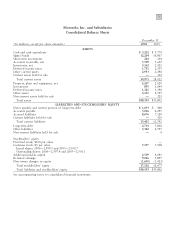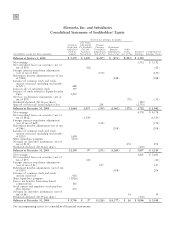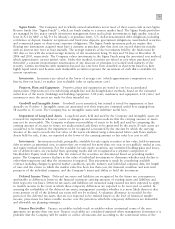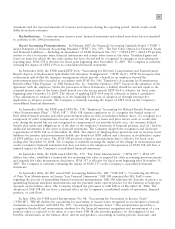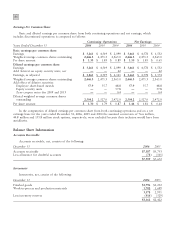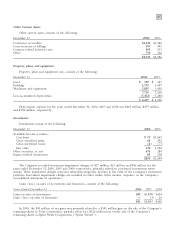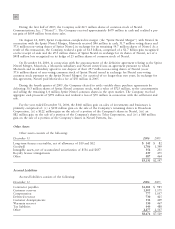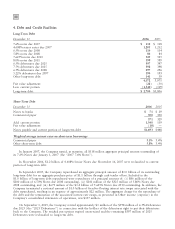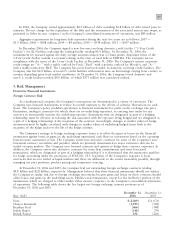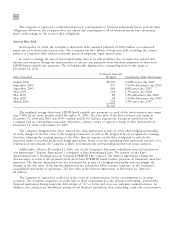Motorola 2006 Annual Report Download - page 89
Download and view the complete annual report
Please find page 89 of the 2006 Motorola annual report below. You can navigate through the pages in the report by either clicking on the pages listed below, or by using the keyword search tool below to find specific information within the annual report.
81
statements and the reported amounts of revenues and expenses during the reporting period. Actual results could
differ from those estimates.
Reclassifications: Certain amounts in prior years' financial statements and related notes have been reclassified
to conform to the 2006 presentation.
Recent Accounting Pronouncements: In February 2007, the Financial Accounting Standards Board (""FASB'')
issued Statement of Financial Accounting Standard (""SFAS'') No. 159, ""The Fair Value Option for Financial Assets
and Financial Liabilities Ì Including an amendment of FASB Statement No. 115'' (""SFAS 159''). SFAS 159 permits
entities to elect to measure many financial instruments and certain other items at fair value. Unrealized gains and
losses on items for which the fair value option has been elected will be recognized in earnings at each subsequent
reporting date. SFAS 159 is effective for fiscal years beginning after November 15, 2007. The Company is currently
assessing the impact of SFAS 159 on its consolidated financial statements.
In September 2006, the FASB issued EITF 06-4, ""Accounting for Deferred Compensation and Postretirement
Benefit Aspects of Endorsement Split-Dollar Life Insurance Arrangements'' (""EITF 06-4''). EITF 06-4 requires that
endorsement split-dollar life insurance arrangements which provide a benefit to an employee beyond the
postretirement period be recorded in accordance with SFAS No. 106, ""Employer's Accounting for Postretirement
Benefits Other Than Pensions'' or APB Opinion No. 12, ""Omnibus OpinionÌ1967'' based on the substance of the
agreement with the employee. Under the provisions of these Statements, a liability should be accrued equal to the
actuarial present value of the future death benefit over the service period. EITF 06-4 is effective for fiscal years
beginning after December 15, 2007. The effects of applying EITF 06-4 may be reflected as either a cumulative-
effect adjustment to retained earnings as of the beginning of the year of adoption or through retrospective
application to all prior periods. The Company is currently assessing the impact of EITF 06-4 on the Company's
consolidated financial statements.
In September 2006, the FASB issued SFAS No. 158, ""Employers' Accounting for Defined Benefit Pension and
Other Postretirement Plans'' (""SFAS 158''). SFAS 158 requires employers to (i) recognize the funded status of
their defined benefit pension and other postretirement plans on their consolidated balance sheet, (ii) recognize as a
component of other comprehensive income, net of tax, the gains or losses and prior service costs or credits that
arise during the period but are not recognized as components of net periodic benefit cost, (iii) measure defined
benefit plan assets and obligations as of the date of the employer's statement of financial position, and (iv) disclose
additional information in the notes to financial statements. The Company adopted the recognition and disclosure
requirements of SFAS 158 as of December 31, 2006. The impact of adopting these provisions was an increase in net
liabilities for pension and postretirement health care benefits of $783 million and a decrease in stockholders' equity
of $514 million, net of taxes. The SFAS 158 provision related to measurement date is effective for fiscal years
ending after December 15, 2008. The Company is currently assessing the impact of the change in measurement date
on the Company's financial statements but does not believe the adoption of this provision of SFAS 158 will have a
material impact on the Company's consolidated financial statements.
In September 2006, the FASB issued SFAS No. 157, ""Fair Value Measurements'' (""SFAS 157''). SFAS 157
defines fair value, establishes a framework for measuring fair value as required by other accounting pronouncements
and expands fair value measurement disclosures. SFAS 157 is effective for fiscal years beginning after November 15,
2007. The Company is currently evaluating the impact of SFAS 157 on the Company's consolidated financial
statements.
In September 2006, the SEC issued Staff Accounting Bulletin No. 108 (""SAB 108''), ""Considering the Effects
of Prior Year Misstatements in Current Year Financial Statements.'' SAB 108 expresses the SEC Staff's views
regarding the process of quantifying financial statement misstatements. SAB 108 addresses the diversity in practice in
quantifying financial statement misstatements and the potential under current practice for the build up of improper
amounts on the balance sheet. The Company adopted the provisions of SAB 108 as of December 31, 2006. The
adoption of SAB 108 did not have a material effect on the Company's consolidated results of operations, financial
position, or cash flows.
In June 2006, the FASB issued Interpretation No. 48, ""Accounting for Uncertainty in Income Taxes''
(""FIN 48''). FIN 48 clarifies the accounting for uncertainty in income taxes recognized in an enterprise's financial
statements in accordance with SFAS No. 109, ""Accounting for Income Taxes.'' This interpretation prescribes a
recognition threshold and measurement attribute for the financial statement recognition and measurement of a tax
position taken or expected to be taken in a tax return. FIN 48 also provides guidance on derecognition of tax
benefits, classification on the balance sheet, interest and penalties, accounting in interim periods, disclosure, and



